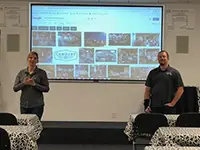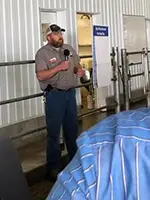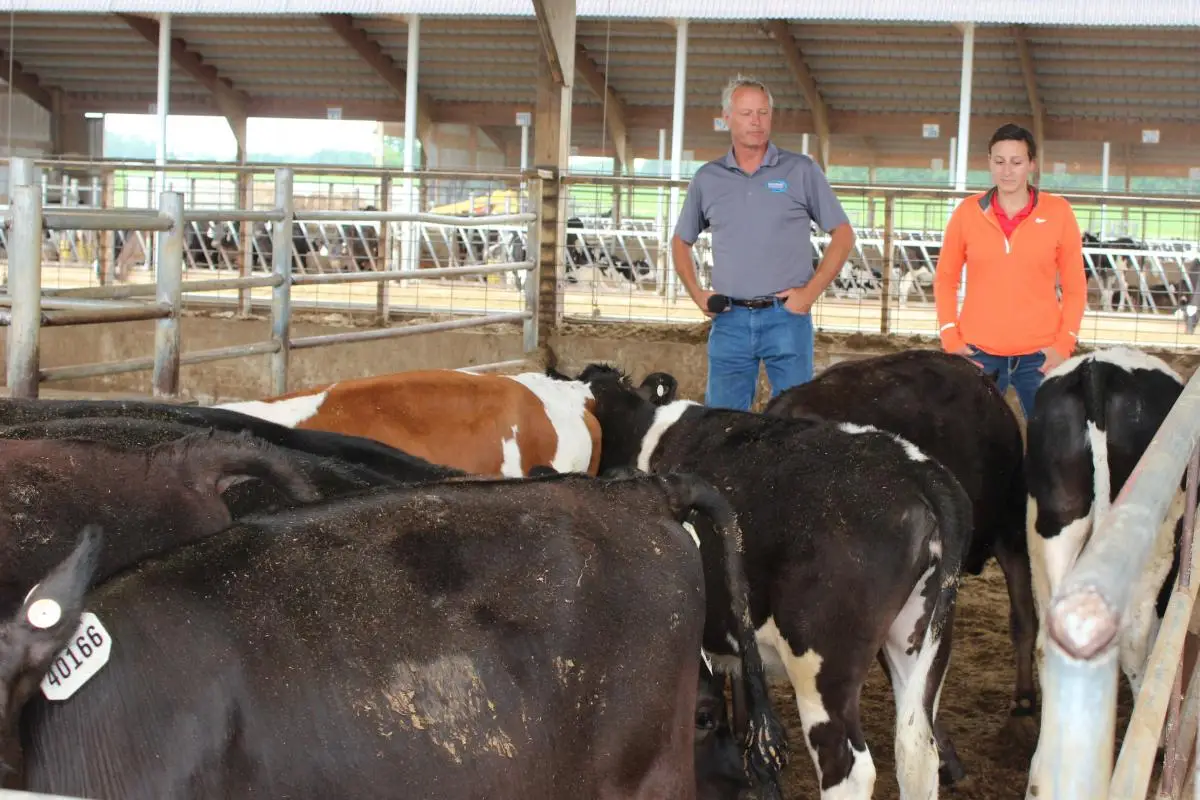
Vita Plus Calf Summit Preconference Farm School: Pagel’s Ponderosa Dairy
 More than milking cows
More than milking cows
Jamie Witcpalek, Pagel’s Ponderosa Dairy chief operating officer, gave a brief history of the farm. It was purchased by her grandparents in 1946, and then her father, John Pagel, in 1980, who grew it to the size it is today. She showed attendees the 72-cow rotary parlor and explained the protocols workers follow before, during and after milking. She also showed a U.S. and world map to demonstrate how people come from all over the world to learn about what the Pagels do to be successful.
Ben Shibler, plant manager of Ponderosa Dairy Products, spoke about some of the Pagels’ other businesses. He said Pagel purchased Ron’s Cheese LLC in Luxemburg, Wisconsin in 2014 and decided to make farmstead cheese fresh from their herd’s milk. In a 12-hour period, the milk goes from their cows, gets made into cheese in their on-farm cheese making facility, and then gets shipped to Ron’s Cheese and other distributors. Shibler said they currently produce 21 different cheeses.
In 2015, Pagel purchased The Cannery Public Market, a farm-to-fork restaurant, market and deli in Green Bay, Wisconsin. The restaurant features all seasonal and local products.
High-quality care
To produce high-quality milk, you need to have high-quality care for your animals. Dr. Brian Stampfl, Valley Veterinary Clinic, gave a brief talk about vaccination protocols on the farm. Stampfl said most vets vaccinate for core diseases, which make up 80 percent of diseases and are highly deadly or pose a high exposure risk. These are scours, respiratory viruses, bovine viral diarrheal virus and clostridial diseases.
Stampfl explained vaccinations are available for these diseases, but that is only part of the equation. He said vaccines need to be administered when the animal is healthy and not stressed. Vaccines should also be treated “like a beer,” according to Stampfl. Keep them cold and use them within an hour after being opened.
 Maternity and dry cows
Maternity and dry cows
Chris Szydel, the Pagel’s herdsman, gave an overview of their maternity program. The dry cow barn was built about two years ago. This allowed them to bring the heifers back to the farm. When they are around 21 days pre-calving, Szydel moves them to the close-up calving area. He said if they show signs of labor in the freestalls, they wait until they see feet and then move them.
Once born, calves are weighed, dried, tagged and given 4 quarts of unpasteurized colostrum. Szydel said they test all colostrum for bacteria and don’t pasteurize colostrum because they don’t want to kill any good colostrum. Everything is written down on a clipboard near the calving pen and initialed by the worker who was present; this holds others accountable.
Dr. Laurie Winkelman, Vita Plus dairy technical specialist, spoke about her top 10 most important things to do for a healthy calf. She emphasized giving each cow plenty of space to do what they need to do, at least 120 square feet per cow. She also emphasized separating mature cows and heifers to prevent drops in dry matter intake, prevent moving them too much, and make sure diets are balanced to prevent any crashing after calving.
Transition and low-stress handling
Cody Yanzick, Vita Plus dairy specialist, provided attendees with his tips to a great transition program. These include designing pens with enough resting space per calf (25 square feet per calf), ensuring each calf has access to feed and water, and the pens have adequate ventilation.
 Jim Lewis, animal handling consultant, spoke about how low-stress handling can impact heifers during transition periods. He said many transition pens are designed with a small curb between the alley and the bunk, and, due to their narrow field of vision, cows typically resist stepping over grates or small curbs. Lewis said performing simple handling practices to move the heifers around the pen to help them find where the feed, water, and curb are located can help prevent drops in intakes.
Jim Lewis, animal handling consultant, spoke about how low-stress handling can impact heifers during transition periods. He said many transition pens are designed with a small curb between the alley and the bunk, and, due to their narrow field of vision, cows typically resist stepping over grates or small curbs. Lewis said performing simple handling practices to move the heifers around the pen to help them find where the feed, water, and curb are located can help prevent drops in intakes.
 Calf barns and feeding regimens
Calf barns and feeding regimens
J.J. Pagel, the Pagel’s dairy manager, talked about features of their calf barns. The Pagels have 12 barns at their calf ranch. Nine barns house calves in individual pens for around two months before they transition to the group pens. J.J. said it took several tries to make the right calf barn for their operation. He said they built all the barns with similar specifications in case one plan didn’t work out and could be easily converted to the other.
To help with drainage in the pens, they started cutting out a piece of the concrete to have a drain. This funnels into a pipeline and then out of the barns into a tank. Pagel said this has helped save a lot of bedding, which has been a major money saver.
Shawn Miller, the Pagel’s calf manager, spoke about how they feed calves on the farm. They are currently feeding 606 calves and give milk twice a day. They use a pail system to indicate if a calf didn’t finish all of her milk or if they are ready to be switched to the next level. Similarly, they have a band system to inform others if a calf needs to be looked at, if they are weaned and ready to move, or if they are weaned but not at the right weight yet.
Miller said they have a 500-gallon holding tank to pasteurize waste milk they feed to calves. They use two carts to feed calves, which allows them to switch to different feeding settings.
Miller and Pagel also discussed their NICU, which is a controlled environment they use to care for sick or stressed calves. It is temperature controlled, which the workers really enjoy in the winter. They emphasized the room is meant for extreme cases, not calves with scours or other minor issues. Between calves, they wash, sanitize, foam and try to let pens sit for about a week.
| Category: |
Business and economics Facility design Farm tours Starting Strong - Calf Care |

